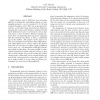100
Voted
CMSB
2008
Springer
15 years 2 months ago
2008
Springer
Model checking has historically been an important tool to verify models of a wide variety of systems. Typically a model has to exhibit certain properties to be classed `acceptable&...
108
Voted
ASM
2008
ASM
15 years 2 months ago
2008
ASM
Abstract. In this paper we examine the difference between model checking high-level and low-level models. In particular, we compare the ProB model checker for the B-method and the ...
97
Voted
EXACT
2007
15 years 3 months ago
2007
Given a model and a property expressed in temporal logic, a model checker normally produces a counterexample in case the model does not satisfy the property. This counterexample i...
96
Voted
ICECCS
2000
IEEE
15 years 4 months ago
2000
IEEE
This paper compares three specification-based testing criteria using Mathur and Wong's PROBSUBSUMES measure. The three criteria are specification-mutation coverage, full pred...
123
click to vote
DFG
2004
Springer
15 years 4 months ago
2004
Springer
This paper presents the real-time model checker RAVEN and related theoretical background. RAVEN augments the efficiency of traditional symbolic model checking with possibilities to...
106
click to vote
CAV
2004
Springer
15 years 4 months ago
2004
Springer
Model checking algorithms can report a property as being true for reasons that may be considered vacuous. Current algorithms for detecting vacuity require either checking a quadrat...
125
Voted
DAC
1996
ACM
15 years 4 months ago
1996
ACM
We present a formal verification methodology that we have used on a computer system design project. The methodology integrates a temporal logic model checker with a conventional pr...
116
Voted
ISSTA
1998
ACM
15 years 4 months ago
1998
ACM
Symbolic model checking has proved highly successful for large nite-state systems, in which states can be compactly encoded using binary decision diagrams (BDDs) or their variants...
SPIN
1999
Springer
15 years 4 months ago
1999
Springer
One of the difficulties of using model checkers “in the large” is the management of all (generated) data during the validation trajectory. It is important that the results obta...
108
Voted
CSFW
1998
IEEE
15 years 4 months ago
1998
IEEE
Model checkers such as FDR have been extremely e ective in checking for, and nding, attacks on cryptographic protocols { see, for example 11, 12, 14] and many of the papers in 3]....


